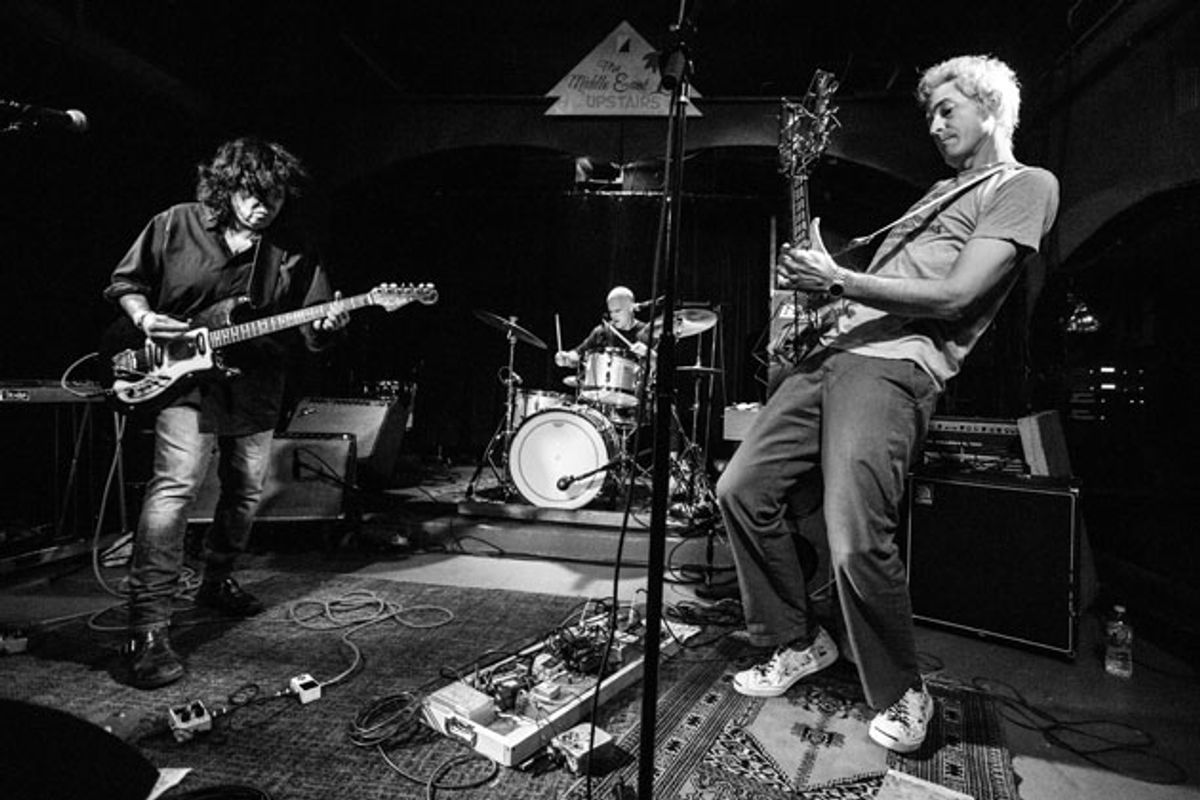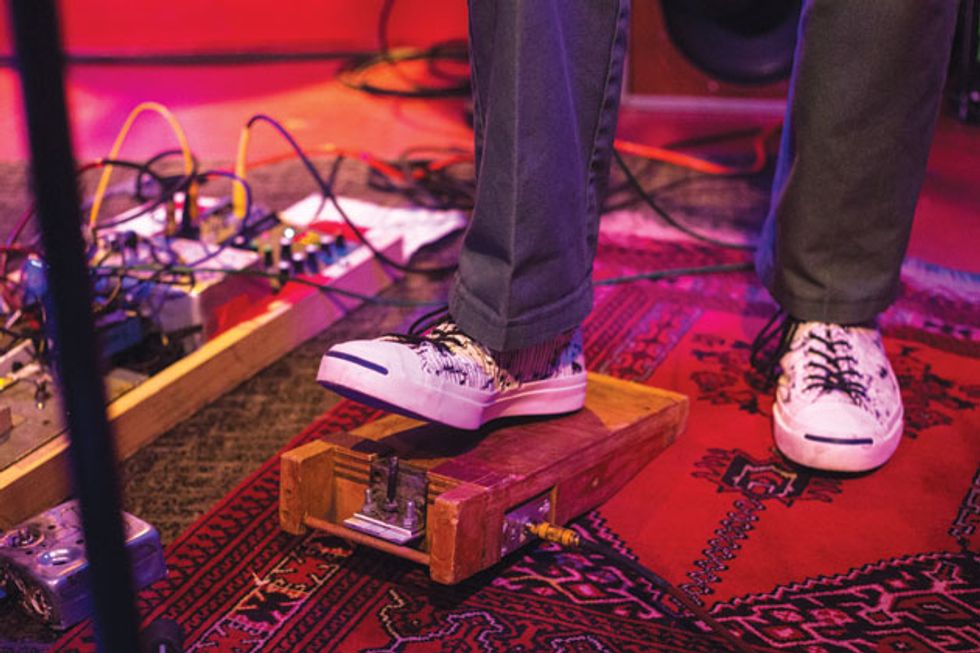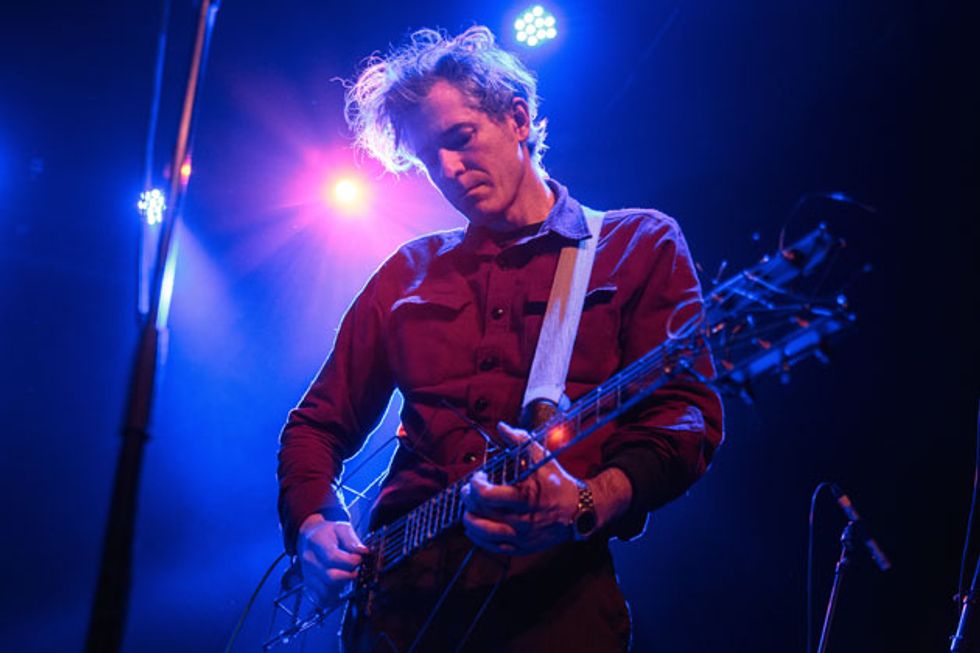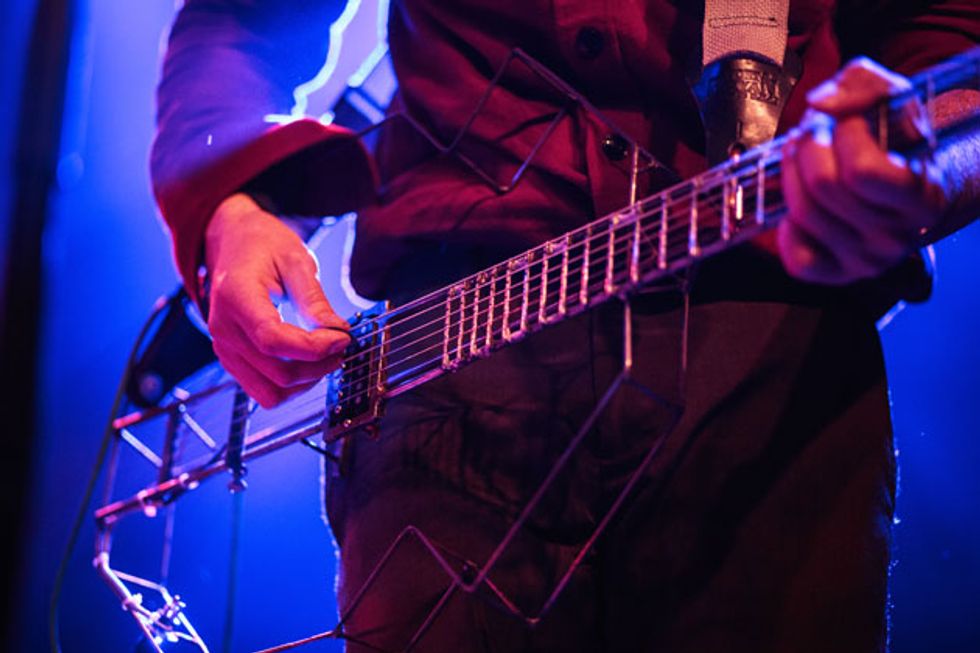The influential artist and her new band E explore the dark and noisy side of songcraft with cheap vintage guitars, homemade instruments, unusual chord voicings, and a triangulated collaboration between two guitars and drums.
“It helps for me to play with a band,” guitarist Thalia Zedek says about her songwriting. “Sometimes I’ll have a song and I just can’t figure out how it should end, or I know there needs to be another part and I can’t really figure it out on my own. I’ve got to go in and play it with the band, and then everything makes sense.”
Don’t misunderstand; Zedek doesn’t only collaborate. Although her latest album’s cover says it’s by the Thalia Zedek Band, Eve is actually her fifth solo release. But synergy is paramount. “When you find someone you really have a strong connection with, it’s pretty special,” she says. Concurrent with Eve’s release is E, the self-titled debut of her trio featuring guitarist/sculptor Jason Sanford of the noise band Neptune and drummer Gavin McCarthy. “E is definitely each of us supplying one side of the triangle,” she says.
Zedek is originally from suburban D.C., although she’s been a Boston fixture since 1979 (apart from a brief flirtation with New York City in the late ’80s). Upon arrival, she worked with a few local bands before joining Dangerous Birds, a group that benefited from a close association with the influential Mission of Burma. “I gigged out in a band called White Women, which was a band I was in for a year or so right before Dangerous Birds,” she says. “We did a lot of fun shows in punk clubs, lofts, and stuff like that.”
After Dangerous Birds, Zedek spent the rest of the ’80s in no wave bands like Uzi and as lead singer—sans guitar—for Live Skull, allowing her to solely pursue her literate and often brooding lyrics. Thanks to the groundwork she laid, Zedek became an influential figure in the indie-rock scene that spawned Nirvana, the Pixies, and Dinosaur Jr., who have all saluted her inspiration.
Her biggest success arrived as a member of Come, a collaboration with guitarist Chris Brokaw, from Codeine, plus drummer Arthur Johnson and bassist Sean O’Brien. “Come’s songs were a bit more conventional than E’s,” she says, distinguishing between her past and current projects. Come broke up in 2001, but reunited in 2013 to tour and commemorate the 20th anniversary of their debut, 11:11. “Chris and I would write together a lot. Arthur and Sean were definitely a big part of it—not taking away from what they added—but the songs would be brought in more complete. Whereas E is, for the most part, spontaneous ideas that come out when the three of us play together.”
Zedek’s music is often dark and brooding, but she isn’t a one-trick pony. Her chord voicings can be wide-open and oddly reminiscent of 80/81-era Pat Metheny. She also crafts subtle textures with modest touches of overdrive, but will get nasty or abrasive when necessary. “There are definitely times where I’m the person making noises,” she says.
Zedek’s primary instrument is the low-budget Hagstrom 1 (she owns two of them). She’s also often seen with a well-loved Fender Tele Deluxe, which she borrowed from a friend. “It has virtually none of the original parts on it,” she says. “I think the neck isn’t even a Deluxe neck, but I don’t know. I got it from Jerry DiRienzo, who was in a band called Cell. I kind of have it on permanent loan.”
Zedek, with her insights framed by decades of experience, opened up to us about—among other things—her influences, collaborations, chord voicings, and the special mojo of cheap gear.
One of your earlier bands, Dangerous Birds, released a single produced by Martin Swope from Mission of Burma. Were you a fan of that band back then?
I was a huge Burma fan back on their first time around. They were really amazing and Roger Miller has definitely been a huge influence on my guitar playing. He still is an amazing guitar player, but back in the ’80s he was super ahead of his time. Martin produced our single and we did a fair amount of shows with them including one right before they broke up back in the ’80s.
You were a big fan of Rowland S. Howard as well. What do you like about his playing?
I love the sound—the bluesy reverb, almost jazzy but really minor key type riffs. I’m a huge fan of the Birthday Party. I think that’s how I discovered him. I also got really into his band These Immortal Souls and even opened up a show for them the one time they played in Boston.
You often work with another guitarist. What do you like about that?
In Come and in my new band E there is another guitarist, but in the Thalia Zedek Band I’ve been the only guitarist for a while, so I wouldn’t necessarily agree with that statement. But that being said, I do really love playing with other guitar players. When you find someone that you really have a strong connection with—like I did with Chris Brokaw and like I do with Jason Sanford—it’s pretty special.
Keith Richards calls it the art of guitar weaving—when you can’t tell which guitar player is playing which part. Do you do that or do you prefer each guitar having a unique voice?
I’m definitely into that. When Come did our reunion shows, I had to relearn a lot of the parts because it had been 20 years since I played some of those songs. I really couldn’t remember what I was playing and what Chris was playing. We had to rehearse a couple of times and I was like, “Who was playing that part? Was that you or was that me?” We honestly couldn’t remember.
In E, even though me and Jason definitely have really strong chemistry between us, our guitar sounds are different. There are things that Jason is doing with his oscillators and crazy metallic contraptions, and I’m playing a more-or-less conventional guitar setup. That is a different kind of thing than Come. Jason and I have different roles in E. Come, it was more a weaving thing—like a Lee Ranaldo/Thurston Moore thing, between me and Chris.
Listening to the E album, the two guitars do sound very different.
Yeah exactly; they are. I’m playing a Hagstrom through a Twin Reverb with some foot pedals. Jason is playing his homemade guitar. He’s splitting his high and low tones through different amps and then he’s got some homemade contraptions. One, inside, has a hacksaw blade that is vibrating against a pickup. The hacksaw blades are tuned to different notes and supply super-low Es, because we don’t have a bass player. [See accompanying sidebar, “Jason Sanford’s Totally Wired Guitar.”.]
Another of Sanford’s creations is this hacksaw box. “It’s essentially like a thumb piano except it’s just got the one tine inside of it and it’s played by stomping instead of with your hands,” he says. Photo by Ben Stas
Talk about your songwriting, and how you approach your solo projects versus group efforts.
They are two very different things. With the Thalia Zedek Band stuff, I more or less write the whole songs myself. It usually comes from noodling around on my guitar at home, coming up with riffs, or just coming across something that I want to work on further. I usually write the music first and the lyrics afterwards. Every once in a while, everything will come out all at once, and obviously I love that—that’s the best. When that doesn’t happen it’s more a labor of love. With E, we write a lot of stuff out of jams. We play a lot together—usually we try to play twice a week, at least—and we record everything and go back over stuff. Just because of the chemistry being the way that it is, there are usually some cool ideas that everyone agrees on in there. We’ll hone in on them and build them into a song. I usually try to not bring in anything more than a brief idea, because I find for E it works best that way: the less information the better. But if I have a cool riff idea, we’ll work on that. Jason sometimes will bring in most of a song—he’ll do that more often than me—but I’d say that was maybe 10 percent of the material. Probably 90 percent is purely collaborative—spontaneous idea generating and then hours of arranging.
The way you voice your chords is very open and interesting. Talk about your harmonic sense and how you come up with chord voicings.
I do tend to use my own voicings. Part of that might be that I just get bored playing barre chords and I don’t quite have the finger stretch to do a lot of the really crazy jazz chords. I tend to break chords down into different three note pieces. I’ll play just part of a chord and get different patterns. I’ll play the top of the chord, the bottom of the chord, or the three middle notes. I also try to keep things as simple as possible. I’ve learned from over the years that I’m not doing myself or the audience any favors by trying to play something that I can barely play. I try to do something that’s within the range of my physical grasp. One of the things about guitar playing is you learn that there are hard ways to do things and easier ways to do things. When you start figuring out what the easier way to do things is, you usually get a big bump in your playing.
Thalia Zedek’s Gear
Guitars
• 2 Hagstrom 1 models
• Fender Telecaster Deluxe
• Kalamazoo KG-1
Amps
• ’70s Fender Twin Reverb (with Eminence Lil’ Texas 12” speakers)
• Fender Princeton Reverb
Effects
• Tokai distortion
• Ibanez Tube Screamer
• Electro-Harmonix Holy Grail Reverb Nano
• Dwarfcraft Devices Total Spack Vibes overdrive
• Electro-Harmonix Stereo Pulsar Variable Shape Analog Tremolo
• Klon KTR Overdrive
• Electro-Harmonix Nano Looper 360
• TC Electronic PolyTune 2
Strings and Picks
• D’Addario EXL 110Ws (.010–.046 with a wound G on the Hagstroms)
• D’Addario EXL 110s (.010–.046)
• Gray Dunlop .88 mm picks
Meaning you can get similar sounds using easier fingerings?
Right. It’s much easier to maneuver. Or depending on where you are going next, you might want to voice a chord in a different way. Some of the reason I voice chords in certain ways is because it works with where I’m going next in terms of the progression.
Do you juxtapose your voicings against the other instruments in the band to complete the chord?
I definitely keep that in mind, for sure, especially with E. Jason and I both seem to sense that if one person is playing high the other person will cover the low stuff. In the Thalia Zedek Band, I have a bass player so I try to stay out of his way. But with E there’s a lot more room to do that. Sometimes I’m just playing bass lines on my guitar, which is really fun.
Talk about your Hagstrom.
I have a Hagstrom 1. I actually have two of them, so I’m a double Hagstrom threat. They’re almost exactly the same guitars—the black ones that were made from the old accordion parts.
What do you like about them?
I love them. I love the tone. To me, they have a really beautiful tone—really deep and sharp, not a lot of mid. The neck is the perfect size for my hands, which like most women’s hands are smaller than guys’. I like a slightly smaller neck. It has a really smooth, thin neck.
Is there a magic to cheaper gear? Does it possess a special mojo?
Definitely yes. I’ve played Mexican-made Fenders or Squiers that sounded better than [American-made] guitars. Even though guitars are made in factories, there is still a lot of individuality between them. That’s what I’ve found. I would never buy a guitar without playing it first, thinking, “Oh it’s a Les Paul so it’s going to be great.” Every guitar is different and definitely some cheap guitars could be great. I think of guitars as individualistic in a way that other things in this world are not necessarily.
What strings do you use?
I use D’Addario strings. Tens with a wound third.
Why a wound third?
Because the Hagstrom actually has a floating wooden bridge and you can’t really adjust the strings. I took it to Jim Mouradian of Mouradian Music in Winchester, Massachusetts. He is, like, a Hagstrom expert. I had a lot of problems with the intonation and with the fixed bridge. It’s just a piece of wood so you can’t really adjust it too much. He said, “Actually, it’s meant to be played with a wound third string.” I started doing that and I really loved the sound. It’s got more sustain and it’s easier to play, so now I use wound thirds on it.
Do you get your distortion from your amp or do you use pedals?
I like to start with a clean sound. Especially with the Thalia Zedek Band, I do a lot of songs clean. I like the sound of the Hagstrom with the Twin and just reverb. That will be my base sound. I prefer to get the overdrive from pedals.
That’s interesting, because on Eve, on “Afloat,” it sounded to me like you were riding your volume knob to get your distortion.
No, I’m using pedals. That starts off completely clean and then I come in with an overdrive. I was trying to make it subtle so it wasn’t like, “Bam!” I come in with it at a time when the band is naturally getting louder. When the whole band comes in loud, I put on an overdrive and keep that on for the whole sections where the vocals are. At the very end there is an overdrive—a really old crappy Japanese overdrive pedal that I love that I’ve been using for years.
What is it?
It’s a Tokai distortion pedal. It’s an old Japanese company. I don’t believe they’re still in business.
Do you use your live rig in the studio or do you experiment?
I usually use what I use live. Right now—recording on a budget and with time constraints—I try to know what I’m going for before I go in there rather than just messing around. For the basic tracks, I’ll definitely do that. Sometimes for overdubs, I’ll borrow stuff. On the Thalia Zedek Band album, I used an electric 12-string and I experimented using different setups for slide. I have a Princeton Reverb at home, too, and I’ll bring that in sometimes for overdubs, just to have a different sound.
Do you try to track live as much as possible or do you lay down scratch parts and redo everything?
I try to do it live as much as possible. Especially on the new Thalia Zedek Band record, some of the songs we recorded didn’t really have endings and there is definitely improvisational stuff—like, I didn’t know when it was going to end, but we just ended at the perfect time. But it’s always different. I like to keep some element of chance in there.
YouTube It
Thalia Zedek, drummer Gavin McCarthy, and guitarist Jason Sanford bring E’s improv-developed music to the stage at Cambridge, Massachusetts’ famed Middle East café. Besides noting their edgy, melodic interplay, check out Sanford’s ingenious wire frame guitar—his own creation.
When Sanford isn’t onstage or jamming in the studio with Zedek, he fronts the band Neptune, who play a variety of handmade, ornamental, and functional instruments.
Jason Sanford’s Totally Wired Guitar
Thalia Zedek’s co-guitarist in E is Jason Sanford. Sanford makes his own instruments—from scratch—and his other band, Neptune, plays only homemade creations. Sanford’s background is in sculpture and his foray into luthiery began as an attempt to create functional art. But it’s grown into much more than that and includes radical designs, applied philosophy, innovative electronics, and stompboxes that function as standalone instruments.
Why did you start building your own instruments?
Jason Sanford: It came out of wanting to make sculpture that was functional, and realizing that musical instruments are exactly that—functional sculpture. But also, just wanting to be more connected to the whole process. To me, being an instrument maker and a musician is similar to being a painter who goes to the trouble of mixing his own paints from the powders and the linseed oil. The end picture may or may not look different, but you’re in touch with the process from the very beginning in a different way.
Did you formally study how to build a guitar?
No [laughs]. It has been a real long process of trial and error. That is just the way I learn. I have to try to do things my own way and find out. I’m always reinventing the wheel, which usually doesn’t pan out, but once in a while I get something really interesting. The first guitar I made had 13 frets to the octave instead of 12. I didn’t really have any idea what would happen, but it taught me a big lesson about why people do it that way—have 12 frets to the octave. I came at it 20 years ago. I really had no musical theory and very little training musically. It’s been an experimental process.
“You can pass your finger right through the fretboard,” Sanford says of his main instrument. “There is no Lucite or anything there. It’s just a wire frame. In part, it’s the evolution of the instruments I’ve built over the years.”
Talk about the guitar you play now.
The guitar I play now, mostly, is a wire frame guitar. Sometimes it’s referred to as a skeleton guitar. It looks like a drawing in space of a guitar. You can pass your hand through the body. You can pass your finger right through the fretboard. There is no Lucite or anything there. It’s just a wire frame. In part, it’s the evolution of the instruments I’ve built over the years. The early guitars I made were heavy scrap metal objects. I used to say that I looked like somebody from the house band in a Mad Max movie. But like a lot of scrap metal sculpture, they carried with them a visual critique of post-industrial waste culture. That kind of thinking was tied up in the visual aesthetic. But eventually, in part after I’d been playing for some years and realizing that these really heavy guitars were taking a toll on my body, I began to think, “Let me not just critique this problem. Can I also think about a solution?” So I began to think about how much can I strip away from the guitar and have it still be a guitar. At this point it’s like a memory of a guitar almost. It still plays like a guitar.
How do you hold it? Is there a metal rod on the back of the neck?
Yes, there is a metal rod in the back. There are basically three rods. It’s like a bridge structure—not a guitar bridge, but a bridge you can cross—or a little bit like the Eiffel Tower or something. It’s got three rods that are braced against each other and then the frets go across the top two rods. You wrap your thumb around the back rod.
Do you have problems with the neck bending or warping?
No, though it is a little bit unsteady in rapidly changing temperature conditions. If we play in a club where it’s really cold or if we do an outdoor gig on a chilly day, I need to be sure to start holding the guitar in my hands before we get onstage for 10 minutes or so, so it will get to my body temperature. Otherwise, the tuning will shift and it will be a little rougher.
Jason Sanford’s Gear
Guitars
• Homemade wire frame guitar
Amps
• Ampeg BA-115 bass amp
• Homemade preamp
• Gallien-Krueger GK200RB
• Homemade cab
Effects
• Homemade hacksaw blade pedal tuned to E
• Homemade bass frequency oscillator tuned to A
• Boss Reverb pedal
Strings and Picks
• Dean Markley Blue Steels (.012–.054, with a .062 or .073 bass string swapped in for the .012s)
• Gray Dunlop .88 mm picks
Is the hardware standard or did you make that as well?
I’ve played around with wrapping my own pickups and creating my own tuning machines, that sort of thing, but it just seems like I need to draw the line somewhere [laughs]. You could go in that direction until you’re mining and refining your own ore [laughs].
How do you tune it?
I have this funny tuning where I’ve got double low E strings and no high upper E string.
So your tuning is E–E–A–D–G–B?
Exactly, that’s it. That’s how I tune it to play in this band E with Thalia.
Are those low E’s an octave or in unison?
It’s in unison, which is interesting. It’s nice once in a while to hit those strings, but one fret off from each other to throw in this dissonant beating thing. That appears on a few of our songs.
Are those strings different gauges or the same?
They are different. One is just a normal low E string and one is a little beefier, like a light-gauged bass string. So that’s a little bit more floppy.
Thalia mentioned you have custom stompboxes with things like hacksaws inside them. Can you tell us about those?
We’re a non-traditional band for a number of reasons, and one of them is we don’t have a bass. We’re two guitars and drums. I wanted to fill up the low end, so I built this stompbox that I use a lot. I stomp on it, but it’s not an effect. It is its own instrument. It’s like a pedal that can rock up and stomp down. It has a guitar pickup inside it—a humbucker—and a single hacksaw blade that is vibrating in front of it. That hacksaw blade is tuned to a low E, like a bass or sub-frequency E. Most of our songs are in E. There are a number of songs where I kick that at the same time that I’m playing an E chord and it fills out the low end a lot.
Does the blade vibrate in sympathy to what the guitar is playing?
When I step on it, I’m physically causing the vibration with the stomping of my foot. It’s essentially like a thumb piano—those are sometimes made with hacksaw blades—except it’s just got the one tine inside of it and it’s played by stomping instead of with your hands.
What other homemade pedals do you use?
I also have a bass frequency oscillator that I built. It’s just an electronic circuit. It’s tuned to a low A. It gets used in a couple of our songs and is controlled by a footswitch, too.
Do you use any conventional pedals?
I do. I use a Boss reverb pedal. I have it set on the very smallest amount of reverb. You can barely hear it, but I’m also using it as a splitter, because I run two amps. I split the signal and I send a clean-ish guitar signal to a bass amp. Then I have a preamp—it’s a circuit of my own design that I made that dirties up the sound a little—and that is a crunchy sound that goes to a guitar amp. So I’m getting a fat, relatively clean, bottom end and then a distorted top end.





